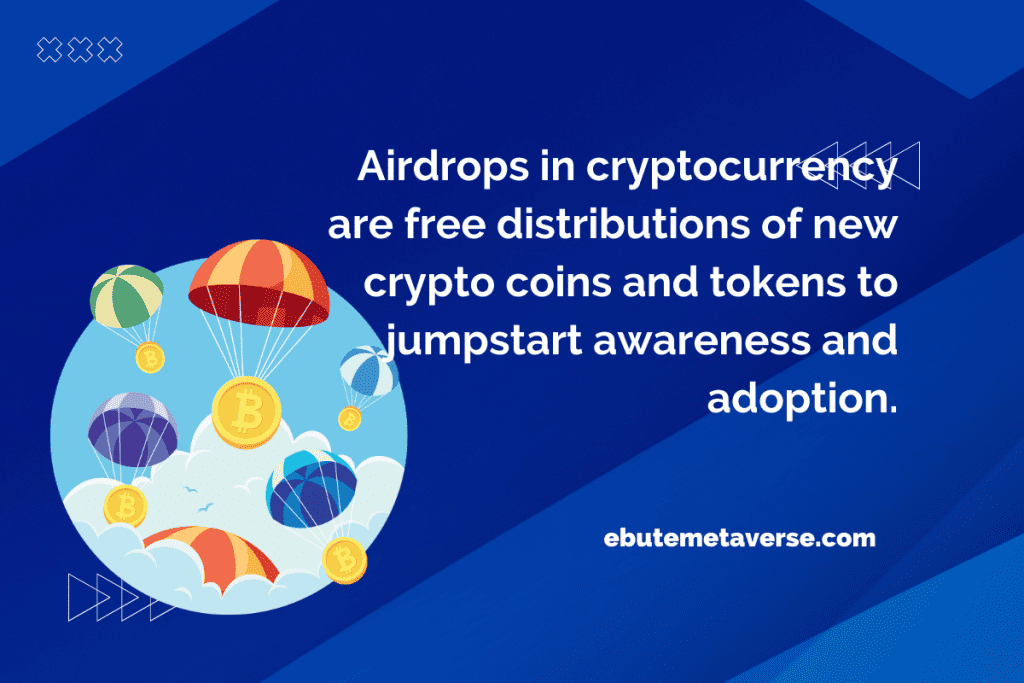Here’s What Airdrop in Cryptocurrency Mean and How It Works
TL; DR
- Airdrops in cryptocurrency are free distributions of new crypto coins and tokens to jumpstart awareness and adoption.
- Main types are holder airdrops, bounty for tasks, smart contract drops, exchange/wallet drops, and fork coin drops.
- Benefits include free crypto for recipients and bootstrapping community usage for projects.
- To get airdrops, hold major coins, use services with drops, follow news. But beware scams and tax implications.
What is Airdrop in Cryptocurrency?
A crypto airdrop refers to the free distribution of new cryptocurrency tokens or coins to a specific group of potential users or token holders. It is primarily used as a way to bootstrap awareness and jumpstart adoption for a new crypto project.
When a cryptocurrency project first launches, they’re faced with two big problems:
- getting their tokens into circulation
- building an initial community
Airdrops provide a way to achieve this by distributing free token allotments to targeted groups and communities.
Table of Contents
What is the Point of an Airdrop in Crypto?
There are several key benefits and incentives for new crypto projects conducting airdrops:
- Generate awareness: Airdrops get people talking about the new cryptocurrency as recipients share news of the free tokens. This sparks interest and attention.
- Bootstrap adoption: Distributing free tokens encourages users to take the new cryptocurrency for a “test drive” since they have nothing to lose. They might even become investors.
- Incentivize actions: Airdrops can require people to perform simple actions like joining a Telegram group or retweeting a post to qualify for the free tokens. This builds the community.
- Fairer distribution: Airdrops allow for a wider, fairer initial distribution of tokens compared to an ICO, where just a few large investors might buy up all tokens.
- Lower barriers: By giving away tokens for free, airdrops have virtually no barrier to entry compared to needing to buy-in during an ICO.

Airdrops allow crypto projects to get their tokens into more hands from the get-go. This is better than being centralized with only a few major holders. An airdrop in cryptocurrency aims to spread awareness and increase decentralized participation.
How Crypto Airdrops Work
The mechanics of a crypto airdrop involve a few key steps:
Setting eligibility requirements
The project behind the airdrop will decide criteria like owning certain coins, following social media accounts, being an active community member, etc. This qualifies people to receive the airdrop.
Taking a snapshot
On a specified date, the project takes a snapshot of an existing blockchain to identify wallets that meet the airdrop eligibility criteria.
Distributing tokens
The new token is distributed to eligible wallets for free and directly deposited by the project. Wallet owners can then claim the tokens.
Recipients claim airdropped coins
Users who received the free crypto can claim it in their wallet. This allows them to access, trade, or hold the new token just like any other coin.
Types of Cryptocurrency Airdrops
There are a few primary types of airdrops executed in the crypto space:
Holder airdrops
Holder airdrops involve distributing free tokens to wallets that hold a minimum balance of a specific cryptocurrency. For example, the OMG airdrop in 2017 sent OMG tokens to all Ethereum wallets with a balance of 0.1 ETH or more.
To identify eligible recipients, the project behind the airdrop will take a snapshot of the blockchain on a specified date. Then, they airdrop tokens to all addresses that meet the threshold holding criteria. This helps target crypto users who are active and familiar with that blockchain’s native asset.
Cryptocurrency projects often use holder airdrops to get new users by tapping into the communities of big coins like BTC and ETH. The minimum threshold balance required can vary.
Bounty Airdrops
Bounty airdrops provide a targeted way to grow awareness and the community. Here, founders distribute free tokens in exchange for recipients completing simple promotional tasks that help market their projects. This can include actions like:
- Joining a Telegram group
- Following a Twitter account
- Retweeting or sharing a post
- Writing a blog post review
The project will outline these bounty tasks and requirements to earn the airdrop. The amounts distributed tend to be much smaller than other airdrop types.
Smart Contract Airdrops
Smart contract-based airdrops automatically distribute free token drops to wallets that interact with the project’s smart contract on the blockchain.
For example, making a transaction on a DApp, staking governance tokens, or providing liquidity to a DeFi protocol tied to the project’s contract can trigger a free token airdrop.
The beauty of smart contract airdrops in cryptocurrency is that they directly incentivize active usage and participation on the new blockchain. This is not just passive holdings of another crypto. This helps bootstrap real user adoption.
Wallet/Exchange Airdrops
Some airdrops target user bases of specific wallets or exchanges by distributing tokens to their registered addresses. For example, projects may airdrop tokens to all addresses held on Coinbase, MetaMask, or other popular services to increase accessibility and visibility.
This allows crypto projects to tap into existing communities centered around major services and platforms in the space. User eligibility is tied more to the service they use rather than holdings.
Fork Airdrops
When a hard fork occurs on a blockchain, creating a new forked cryptocurrency, the new forked coins are often airdropped to holders of the legacy chain.
For example, Bitcoin Cash was airdropped to all BTC holders at a 1:1 ratio after the hard fork. This was meant to provide a wider initial distribution of the new asset to interested users of the old chain.
Fork airdrops provide a built-in community of potential users ready to experiment with the capabilities of the new forked chain. The ratio of new coins distributed can vary.
Further Reading: How to Identify Fake Airdrops + 8 Steps to DYOR
What are the Benefits of Crypto Airdrops?
Airdrops can benefit both the cryptocurrency projects doing the airdrop and the recipients who receive the free tokens.
For the project
- Builds immediate community and awareness for a new crypto coin.
- Incentivizes users to try out the new blockchain technology.
- Grows reach to wallet addresses and communities they want to target.
- Allows wide distribution of tokens for greater decentralization.
For recipients
- Get free crypto coins that could appreciate in value.
- Opportunity to become early adopters of new projects with potential.
- Chance to earn money by trading or selling the airdropped coins.
- No downside since receiving airdrops is free and carries no risk.
- Incentive to learn more about new crypto projects.
Successful Airdrops in Crypto History
Some of the most well-known cryptocurrency projects bootstrapped growth through airdrops early on:
- Uniswap – 400 UNI tokens were airdropped to all wallets that had ever interacted with Uniswap. The UNI token increased 1,000% in price after the 2020 airdrop.
- Stellar – In 2016, the Stellar Development Foundation airdropped roughly 19 billion XLM tokens to Bitcoin holders, instantly becoming one of the largest airdrops ever.
- OMG – In 2017, OMG (OmiseGo) airdropped tokens to Ethereum holders with more than 0.1 ETH, distributing 5% of the entire OMG supply. The price shot up 200%+ after the airdrop.
- Ontology – Ontology airdropped free ONT coins to holders of NEO, driving awareness of what was then a relatively unknown project. The number of ONT holders grew from under 12,000 to over 60,000 following the 2018 airdrop.
How to Join Crypto Airdrops
Some tips on how to get free coins from crypto airdrops:
- Hold larger cap coins that serve as common bases for airdrops, like Bitcoin, Ethereum, Litecoin.
- Actively use DApps, DeFi protocols, wallets, exchanges where airdrops commonly occur.
- Follow airdrop announcement channels on Twitter, Telegram, Reddit to stay updated.
- Join airdrop community groups and submit information to qualify.
- Enable receiving of new tokens in your wallet settings.
- Never share private keys or directly interact with unverified token contracts.
Crypto Airdrop Scams
While many airdrops are legitimate projects looking to organically grow, some are outright scams trying to capitalize on hype to steal coins and tokens. Be watchful of:
- Airdrops requiring substantial personal information like ID scans or selfies.
- Airdrops that seem too good to be true, offering massive bonuses or rewards.
- Projects with anonymous teams, no online presence, or questionable whitepapers.
- Airdrops requiring you to buy coins first before claiming.
- Airdrops asking for private keys or to connect your wallet.
Stick to established legit projects and be cautious sharing any sensitive information to stay safe.
Further Reading: How to Spot a Crypto Airdrop Scam and Stay Safe
Cryptocurrency Airdrops and Taxes
Depending on your jurisdiction, receiving coins from airdrops may be considered income subject to taxes. Some key things to note:
- In the U.S., free coins from airdrops are treated as regular income by the IRS based on the market value at the time of receipt.
- This tax liability applies even if you choose not to claim the coins from an airdrop.
- Trading or selling the coins later also triggers capital gains taxes like other cryptocurrencies.
- Documenting airdrops amounts and values can avoid major headaches at tax time.
- Some regions, like Portugal and Singapore, currently have no taxes on cryptocurrency income.
Always check local tax laws to make sure you meet reporting requirements for any crypto-related income like airdrops.
FAQs
Are crypto airdrops free money?
Yes, airdrops do provide recipients with free cryptocurrency. But it usually requires satisfying certain eligibility criteria, whether holding tokens or performing tasks. And free airdrop coins may be subject to income taxes.
Is crypto airdrop profitable?
Airdrops can be quite lucrative if received early for projects that substantially increase in value later on. For example, the UNI airdrop of 2020 would be worth around $8,000 per recipient today given UNI’s rise. But like any investment, future profits are not guaranteed.
Do you have to pay for airdrops?
Legitimate airdrops are free distributions of cryptocurrency to help bootstrap projects. You should never have to directly pay or buy tokens to qualify for an airdrop, unless it is to cover trivial gas fees on a blockchain. Beware of “airdrops” that require upfront payments or investment.
How much can you earn from airdrops?
Earnings from airdrops vary substantially based on the project and amount of tokens distributed. Some smaller airdrops may only be worth a few dollars, while larger ones could earn hundreds or thousands if the project takes off. For example, the initial Stellar airdrop was valued at over $10,000 per participant at XLM’s peak price.
How do you benefit from crypto airdrops?
The main benefits are receiving free crypto that could gain value over time, getting early access to new projects and communities, having tokens to experiment with new blockchain platforms, and sometimes earning promotional rewards for social media/marketing tasks.
What does Airdropping mean in crypto?
In crypto, airdropping refers to projects distributing free tokens or coins to user wallets, communities, or existing token holders in order to jumpstart awareness, usage, and decentralization. It represents a form of free giveaway marketing.
What is an example of an airdrop in crypto?
A prominent example was the 2020 Uniswap airdrop which distributed 400 UNI tokens for free to around 22,000 wallets that had ever interacted with Uniswap’s protocol. This instantly made UNI one of the largest DeFi tokens and boosted Uniswap’s userbase.
Summary

Airdrops involve sending out free cryptocurrency coins or tokens to boost awareness and provide fair distribution for new projects. They represent an innovative marketing tactic in the crypto industry. Participants can receive value, while projects can bootstrap engagement and growth. Just be sure to do research and exercise caution to avoid scams or taxes. When planned properly, airdrops can be beneficial for all parties involved.





